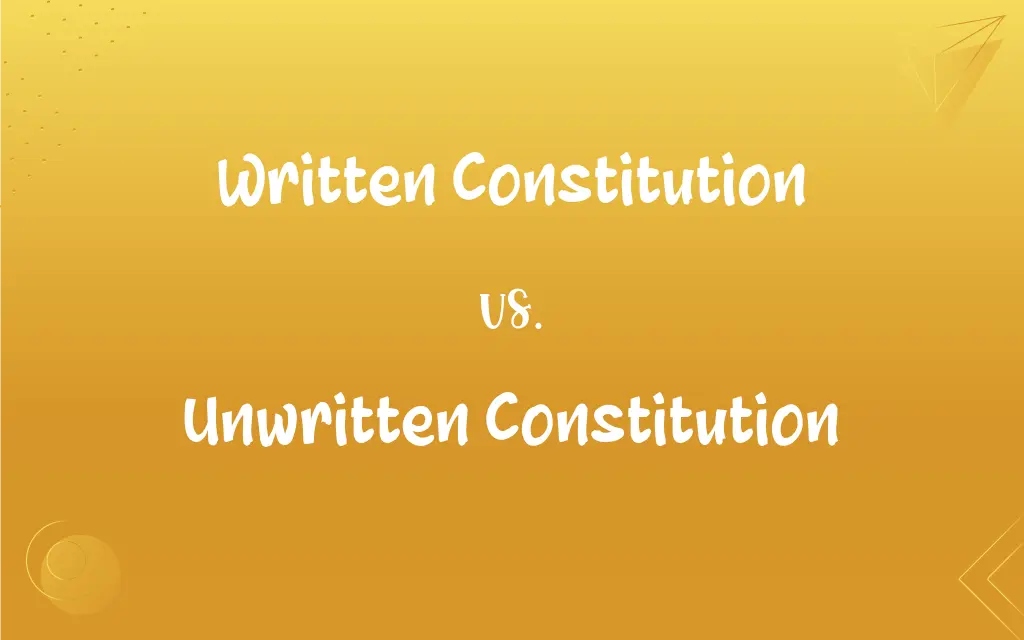Written Constitution vs. Unwritten Constitution: What's the Difference?
Edited by Aimie Carlson || By Janet White || Published on February 26, 2024
A written constitution is a formal document defining the structure, powers, and limits of government, while an unwritten constitution consists of customs, judicial decisions, and legal precedents not codified in a single text.

Key Differences
A written constitution is a codified document that explicitly outlines the fundamental laws, principles, and organization of a state. An unwritten constitution, however, relies on an evolving set of laws derived from various sources such as judicial decisions, legal precedents, and cultural customs.
Written constitutions provide a clear, accessible reference for the government structure and citizen rights, often seen as more stable and predictable. In contrast, unwritten constitutions offer greater flexibility and adaptability, evolving with changing societal norms and judicial interpretations.
Amendments to a written constitution usually require a formal and often rigorous process, making changes more deliberate. An unwritten constitution, however, changes more fluidly through new court rulings, legislative actions, and shifts in conventions.
Countries with a written constitution have a definitive source for legal reference, which can aid in resolving disputes about governmental powers and citizen rights. Conversely, countries with an unwritten constitution often rely on a combination of historical documents, legal statutes, and conventions, which can provide more room for interpretation and adjustment.
Written constitutions often symbolize a nation's identity and values, providing a sense of continuity and national unity. Unwritten constitutions, being a collection of various traditions and practices, reflect a country's historical evolution and can be seen as more organic.
ADVERTISEMENT
Comparison Chart
Form
Codified in a single document
Composed of unwritten customs and precedents
Flexibility
Generally rigid and requires formal amendments
More flexible and evolves over time
Source of Reference
Clear and definitive text
Various sources like judicial decisions, laws
Interpretation
Relatively fixed interpretation
Subject to broader interpretation and evolution
Amendment Process
Formal and often difficult
Informal and continuous through new precedents
ADVERTISEMENT
Written Constitution and Unwritten Constitution Definitions
Written Constitution
Written constitutions provide a clear framework for governmental powers and citizen rights.
South Africa's post-apartheid written constitution emphasizes human rights.
Unwritten Constitution
Unwritten constitutions allow for flexibility and adaptability to changing circumstances.
Israel, without a formal written constitution, relies on an unwritten one.
Written Constitution
A written constitution is a formally adopted legal document outlining a government's structure.
The U.S. Constitution is a written constitution that established the federal system.
Unwritten Constitution
Unwritten constitutions are often based on long-standing practices and conventions.
The concept of parliamentary sovereignty in the UK is part of its unwritten constitution.
Written Constitution
A written constitution serves as the supreme law of the land.
The French Fifth Republic operates under a written constitution.
Unwritten Constitution
An unwritten constitution evolves through judicial decisions and parliamentary statutes.
New Zealand's constitution is unwritten, evolving through laws and conventions.
Written Constitution
A written constitution is a codified set of laws and principles that govern a nation.
India’s written constitution is the longest in the world.
Unwritten Constitution
An unwritten constitution is a set of traditions, customs, and precedents that collectively form a country's constitution.
The United Kingdom operates under an unwritten constitution.
Written Constitution
Written constitutions often include a bill of rights.
The first ten amendments to the U.S. Constitution are known as the Bill of Rights.
Unwritten Constitution
An unwritten constitution is not codified in a single document but found in various legal and historical texts.
Canada’s constitution before the 1982 patriation was largely unwritten.
FAQs
What is a written constitution?
A written constitution is a formal document that defines the structure of a government, the powers of its branches, and the rights of citizens.
What is an unwritten constitution?
An unwritten constitution isn't a single, formal document. It's based on customs, judicial decisions, and legislative statutes.
Can a country have both written and unwritten constitutions?
Yes, a country can have a mix of both, with a formal written constitution supplemented by unwritten traditions and practices.
What is an example of a country with a written constitution?
The United States is an example, with its Constitution written in 1787.
How does a written constitution protect civil liberties?
It often includes a bill of rights or similar section that explicitly protects specific liberties and rights.
How does an unwritten constitution protect civil liberties?
Through judicial interpretations and legislative actions that uphold and define civil liberties over time.
Is a written constitution always entirely written?
Mostly yes, but interpretations and supplementary laws also play a significant role in its application.
What is an example of a country with an unwritten constitution?
The United Kingdom has an unwritten constitution, based on statutes, conventions, and legal documents.
How are amendments made to a written constitution?
Amendments usually require a special process more rigorous than regular legislation, often involving both legislative and popular approval.
What are the advantages of a written constitution?
Clarity and stability, as it clearly outlines the government's structure, powers, and citizen rights.
What are the disadvantages of a written constitution?
Rigidity and difficulty to adapt to societal changes due to the complex amendment process.
How are changes made to an unwritten constitution?
Changes can occur more fluidly through new legislation, judicial decisions, or shifts in customary practices.
What are the advantages of an unwritten constitution?
Flexibility and adaptability to changing circumstances without formal amendments.
Can an unwritten constitution be documented?
Elements of it, like statutes and court decisions, are documented, but not in a single, comprehensive document.
Which is more common globally, written or unwritten constitutions?
Written constitutions are more common, as most modern states prefer having formal constitutional documents.
How does a written constitution influence the legal system?
It serves as the supreme law, guiding legislation, judicial decisions, and government actions.
How does an unwritten constitution influence the legal system?
It shapes the legal system through evolving traditions, case law, and legislative practices.
What are the disadvantages of an unwritten constitution?
Potential for ambiguity and inconsistency, and it may be less accessible to the general public.
Can a written constitution be based on historical documents?
Yes, many are influenced by historical charters, declarations, and previous legal systems.
How do citizens interact with an unwritten constitution?
Through participation in democratic processes, legal challenges, and societal debates that shape its interpretation and evolution.
About Author
Written by
Janet WhiteJanet White has been an esteemed writer and blogger for Difference Wiki. Holding a Master's degree in Science and Medical Journalism from the prestigious Boston University, she has consistently demonstrated her expertise and passion for her field. When she's not immersed in her work, Janet relishes her time exercising, delving into a good book, and cherishing moments with friends and family.
Edited by
Aimie CarlsonAimie Carlson, holding a master's degree in English literature, is a fervent English language enthusiast. She lends her writing talents to Difference Wiki, a prominent website that specializes in comparisons, offering readers insightful analyses that both captivate and inform.






































































